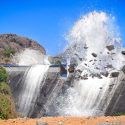Deep under the Earth’s surface, there’s a scorching hot ball of metal. Scientists just discovered that something very wrong is happening to it. Did Earth’s inner core really stop spinning? What apocalyptic events could this trigger? And are we doomed to become as lifeless as Mars?
If you were to dig straight down into our planet, you’d shovel through four distinct layers on your way to the center. First, there’s the rocky crust, that’s followed by the hot liquid mantle. 2,900 km (1,800 mi) later, you’d reach Earth’s outer core, made up of liquid iron and nickel. Combined with the solid iron inner core, the two core layers of our planet are about the size of Mars. But unlike the red planet, they’re scorching hot. At 10,000 °C (18,032 °F), they’re hotter than the surface of the Sun.
There’s also a lot of movement down there. The motion of molten metal in the outer core is what’s responsible for generating Earth’s magnetic field. Without that, we wouldn’t be able to hold onto our atmosphere and we’d lose our protection from dangerous space radiation. The inner core of our planet is moving too. But new research suggests that it’s slowing down to rotate more in sync with the rest of the planet. But slowing down isn’t dramatic enough. Let’s see what happens when both layers of the core stop moving completely.
If only the hot, solid inner core inside the outer core stopped moving, you wouldn’t need to worry about the apocalypse just yet. The slowing down of the inner core would mostly impact the speed at which Earth spins. It could slow our rotation down enough that our days would become longer. And over time, this could degrade our magnetic field. That would be bad news. But not nearly as bad as what would happen if the syrupy outer core stopped spinning too. Without that layer’s rotation, you’d have to kiss our magnetic field goodbye. This would put Earth on course to end up looking a lot like Mars.
4.2 billion years ago, Mars could have been warm enough to have oceans where life may have thrived. But when the red planet’s core froze in place, its once-strong magnetic field weakened. As the Martian magnetic field degraded, its atmosphere was chipped away by ferocious solar winds slamming into the planet at speeds of several hundred km/s. That’s when the planet transformed into the dry, lifeless desert you know today.
But back to Earth. Before it completely turned into a desert planet, things would get a little shaky. If the core was to suddenly stop rotating, the tectonic plates would violently slam into each other. It would be a lot like when your bus driver hits the brakes hard and you go flying into the other bus riders. This sudden collision of tectonic plates would cause massive earthquakes along the plate boundaries all around the world. These quakes would destroy buildings, roads and bridges. Electricity, phone lines and water systems would be severed. Ultimately, millions of lives would be lost and millions more people displaced.
Now, as devastating as these earthquakes would be, the damage would just be getting started. With the disappearance of our magnetic field, you’d be exposed to dangerous cosmic radiation that would bombard the surface of our planet. These high-energy particles from the Sun would interact with the abundance of nitrogen and oxygen in our atmosphere. This would destroy our protective ozone layer, allowing more UV radiation to reach the surface. Combining these solar rays and UV radiation would be enormously harmful to all life on Earth. It would damage your DNA, leading to mutations and cancer.
The halting of the core would also make navigating the globe more difficult. I hope you have a good trail map for your next camping trip because compasses would be totally useless. All kinds of migratory animals would lose their way too. Birds flying south would get lost and freeze to death, while sea turtles would never find their way back to the beaches that they lay their eggs on. The earthquakes caused by the core suddenly stopping would have already done significant damage to power infrastructure around the world. But the lack of a magnetic field would continue disrupting things even more. The solar radiation bombarding the surface would damage all kinds of electronic devices, and would threaten our power grids. You would end up losing power more often. Maybe even permanently.
But, in reality, you don’t have to worry about a catastrophe like this. This study, which implied that the core has stopped and we’re all doomed, was a little overhyped. Scientists didn’t even talk about the outer core. No, they just meant the inner core, which rotates independently from the rest of the planet. It doesn’t stop or reverse its rotation. It just moves slower and faster, like it’s done for the billions of years of our planet’s existence. Good news, everyone, we’re safe on our big, blue space rock.
Sources
- Why Earth’s Inner Core May Be Slowing Down. Pappas, S (2023). Scientific American.
- How Mars lost its atmosphere, and why Earth didn’t. Achenbach, J (2017). The Washington Post.
- Habitability and the Evolution of Life Under Our Magnetic Shield. Lingam, M (2020). Eos.
- 6 Horrible Consequences of Earth Losing its Magnetic Field. (2015). Futurism.
- Astronomers Show Magnetic Field is Critical for Life. (2016). Harvard Smithsonian Centre For Astrophysics.



























